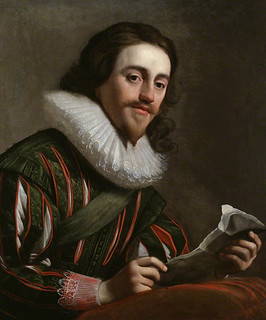
PREV ARTICLE
NEXT ARTICLE
FULL ISSUE
PREV FULL ISSUE
CHARLES I AND THE ROYAL TOUCHDavid Pickup submitted this follow-up with more background on touch pieces, coins linked to an ancient royal ceremony when monarchs touched people who who believed the act could cure their disease. -Editor Don't touch me! Continuing looking at coins and health last week we looked at touch pieces and how they fell out of favour with William III but were still used by the Jacobites. This week I want to go back to earlier in the Seventeenth Century. Touching ceremonies were very popular at the French court and it is possible that Charles I may have been influenced by his French queen to carry on the tradition that his Scottish father, James I disapproved of. Under Charles the ceremony became so popular that people tried to go back in for a second go. The authorities insisted that candidates had to get a certificate from a pastor and royal authority to show that they were first timers.
In 1642 the king was forced by the Civil War to move his court to Oxford. Even though there was fighting going on Parliament granted passes to people to travel along the river Thames to Oxford with sick children to be touched in the hope of a cure. In 1643 there was petition from people wanting their king back to London for the touching. This too was a piece of propaganda, possibly from moderates wanting to mediate a settlement. After the Civil War when Charles was in captivity in Northamptonshire and then on the Isle of Wight the touching ceremonies continued but was unable to hand out coins. The public brought their own ribbons and souvenirs for him to touch. Stories of Charles curing the lame and blind built up an image of a Christ like King and eventual martyr. After his execution there was a scrabble for his mementos and clothes dipped in royal blood. After Charles' death an enterprising businessman set out tours to the continent for people who wanted to be cured by Charles II in exile. He was an enthusiastic "toucher" in more than one way" One of his illegitimate offspring, the Duke of Monmouth, later tried to seize the crown. One of the charges against him was he pretended to use the Royal touch.
To read the Wikpedia entry on Charles I, see:
To read the earlier E-Sylum article, see:

Wayne Homren, Editor The Numismatic Bibliomania Society is a non-profit organization promoting numismatic literature. See our web site at coinbooks.org. To submit items for publication in The E-Sylum, write to the Editor at this address: whomren@gmail.com To subscribe go to: https://my.binhost.com/lists/listinfo/esylum All Rights Reserved. NBS Home Page Contact the NBS webmaster 
|
